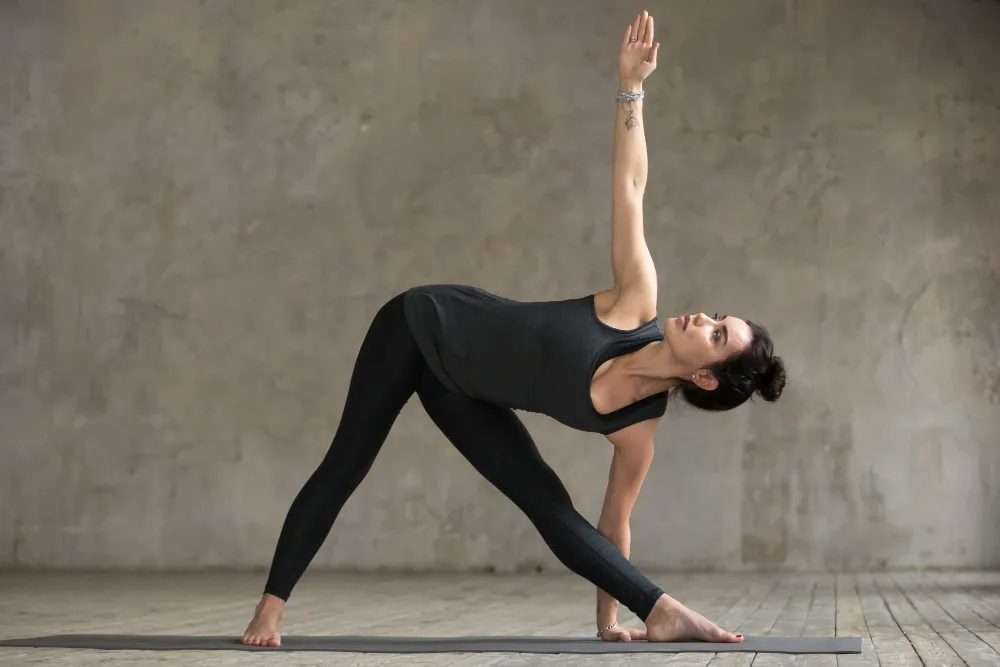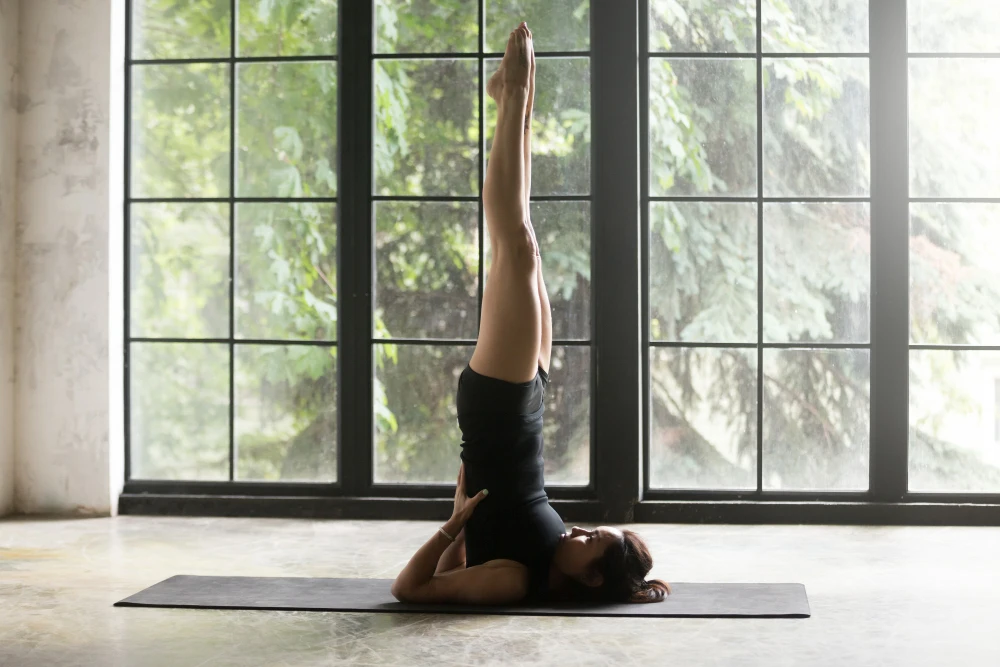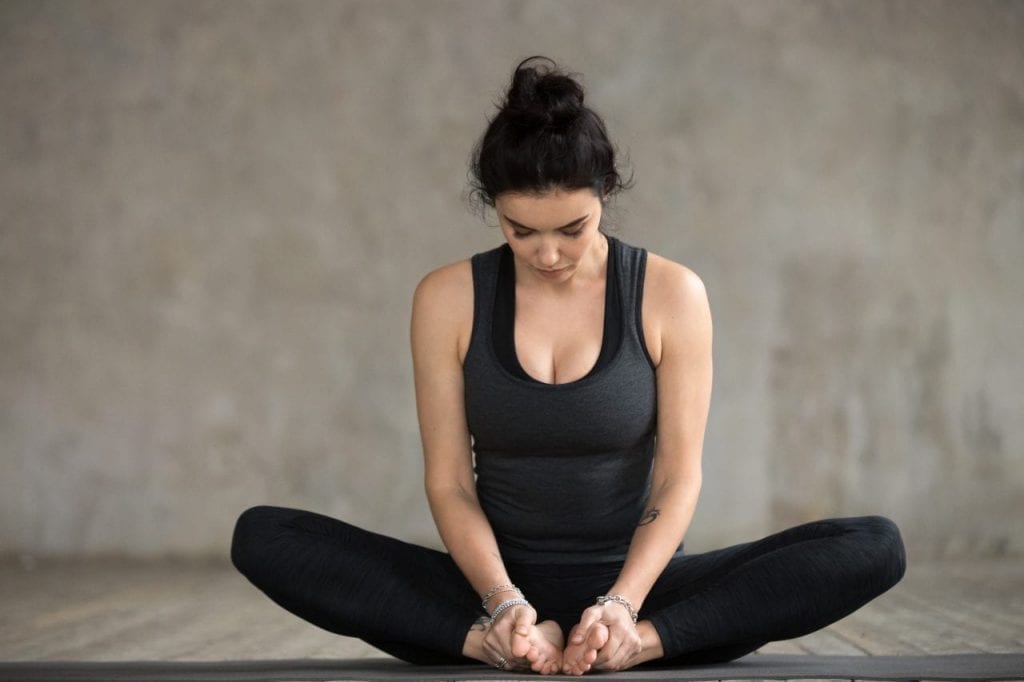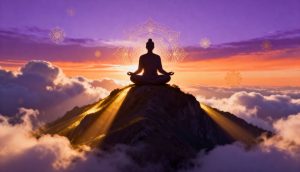Are you looking for an exercise routine that challenges both your mind and body? Then, you should definitely try Ashtanga yoga.
What is Ashtanga yoga?
The Ashtanga Yoga is a dynamic and structured style of yoga that combines fluid movements, controlled breathing, and a fixed sequence of postures.
It is a demanding practice that emphasizes the connection between mind, body, and breath through a rigorous physical discipline.
The term “Ashtanga” comes from Sanskrit and means “eight branches” or “eight steps”, according to the yoga system described in the Yoga Sutras of Patanjali.
However, Ashtanga Yoga as a style of modern physical practice was developed and popularized by Sri K. Pattabhi Jois in India.

Features of Ashtanga yoga
Here we explore its main features to better understand this practice:
Fixed Sequence of Poses
The Ashtanga Yoga is organized into six progressive series:
- First series (Yoga Chikitsa): Cleanses and detoxifies the body.
- Second series (Nadi Shodhana): Purifies the nervous system.
- Advanced series (Sthira Bhaga): Develop extreme strength and stability.
Each series follows a strict order that is repeated in each practice.
Movement and Breath Synchronization (Vinyasa)
One of the essential aspects of Ashtanga Yoga is the dynamic flow. Each movement is synchronized with an inhalation or exhalation, creating a fluid and rhythmic practice that strengthens the body and mind.
Ujjayi Breathing
The deep breathing technique known as “Ujjayi” is central to this practice. It produces a soft sound that generates internal heat, helps to maintain focus and contributes to the detoxification of the body through sweat.
Use of Bandhas (Energy Locks)
The bandhas are specific muscle contractions that are activated during practice:
- Mula Bandha: At the base of the pelvic floor.
- Uddiyana Bandha: In the abdominal area.
- Jalandhara Bandha: In the throat.
These closures control and channel vital energy (prana).
Focus of the Gaze (Drishti)
During each posture, the gaze is directed at a specific point (for example, the tip of the nose or the space between the eyebrows). This not only helps maintain physical stability but also encourages concentration and active meditation.
Internal Heat Generation
The constant movement, combined with Ujjayi breathing, generates an internal heat that detoxifies the body from the inside. The sweat produced is a reflection of this purifying process.
Discipline and Consistency
Ashtanga Yoga requires commitment. By repeating the same sequences, practitioners deepen into each posture and develop strength, flexibility, and mental endurance over time.
Gradual Progression
The progress is intentional and controlled. A practitioner does not move on to the next series until they master the current one, which ensures adequate physical and mental preparation.
Mysore Style: An Individualized Practice
In the “Mysore Style”, students practice the sequence at their own pace, with the guidance of a teacher who adjusts and corrects the poses according to individual needs.

The History of Ashtanga Yoga
The Ashtanga Yoga has its roots in the ancient text “Yoga Korunta,” attributed to the sage Vamana Rishi. This text, written on palm leaves, detailed a dynamic method of Hatha Yoga that included sequences of postures connected with breath, specific movements, and points of focus.
In the 20th century, Krishnamacharya, one of the great yoga masters, rediscovered the “Yoga Korunta” in the Calcutta Library. Over time, he taught its contents to his disciple K. Pattabhi Jois, who later systematized these teachings into what we know today as Ashtanga Vinyasa Yoga.
Unfortunately, the original text was lost after its disintegration, and its content survives only through this tradition.
In the 1970s, Pattabhi Jois began teaching Ashtanga Yoga in the West, passing this style on to students like David Williams, Nancy Gilgoff, and David Swenson, who popularized it globally.
Your book, Yoga Mala (1962), also contributed to the spread of this practice. Today, Ashtanga Yoga is one of the most recognized and practiced forms of yoga in the world, combining tradition, discipline, and dynamism.
Ashtanga Yoga Postures
The asanas are organized into six series, each with a level of difficulty and a focus on specific bodywork.
The first series, known as Yoga Chikitsa, focuses on body alignment and detoxification. The second, Nadi Shodana, purifies the nervous system. Subsequent series focus on strength and endurance.
Below are some of the main asanas:
The practice begins with the Sun Salutations A and B (Surya Namaskara A and B), which warm the body and prepare for the standing poses. Among these are Utthita Trikonasana (Extended Triangle), Parivrtta Parsvakonasana (Revolved Side Angle), and Prasarita Padottanasana (Wide-Legged Forward Bend).

The sitting postures include asanas such as Paschimottanasana (Seated Forward Bend), Janu Sirsasana (Head-to-Knee Pose), Marichyasana (Marichi’s Pose), and Navasana (Boat Pose), which develop flexibility and balance.

In the investments section, poses such as Sarvangasana (Shoulder Stand), Halasana (Plow Pose), and Sirsasana (Head Stand) are practiced.

The practice concludes with Padmasana (Lotus Position), Yoga Mudra (Seal of Yoga), and relaxation in Savasana (Corpse Position), integrating the benefits of the practice.

This posture structure is the foundation of the First Series (Yoga Chikitsa), and prepares the practitioner to progress to more advanced series over time.
The six-day-a-week method: Mysore Style
In the tradition of Ashtanga Yoga, daily practice is a fundamental pillar, with a structure that spans six days a week. The only rest days are Saturdays and the days of full moon and new moon, known as “yoga holidays.”
These breaks not only allow the body to recover, but also honor the natural rhythms of the cosmos.
In a four-week cycle, this routine allows for 22 days of practice, alternating between weeks of six and five days. This constant rhythm is designed to cultivate the discipline, mental strength, and spiritual devotion necessary to advance on the inner path of yoga.
Practicing Ashtanga Yoga six days a week not only strengthens the body but also fosters a deep commitment to the pursuit of inner peace.
It is an invitation to practitioners to integrate yoga as an essential part of their daily lives, benefiting both the mind and the spirit.







